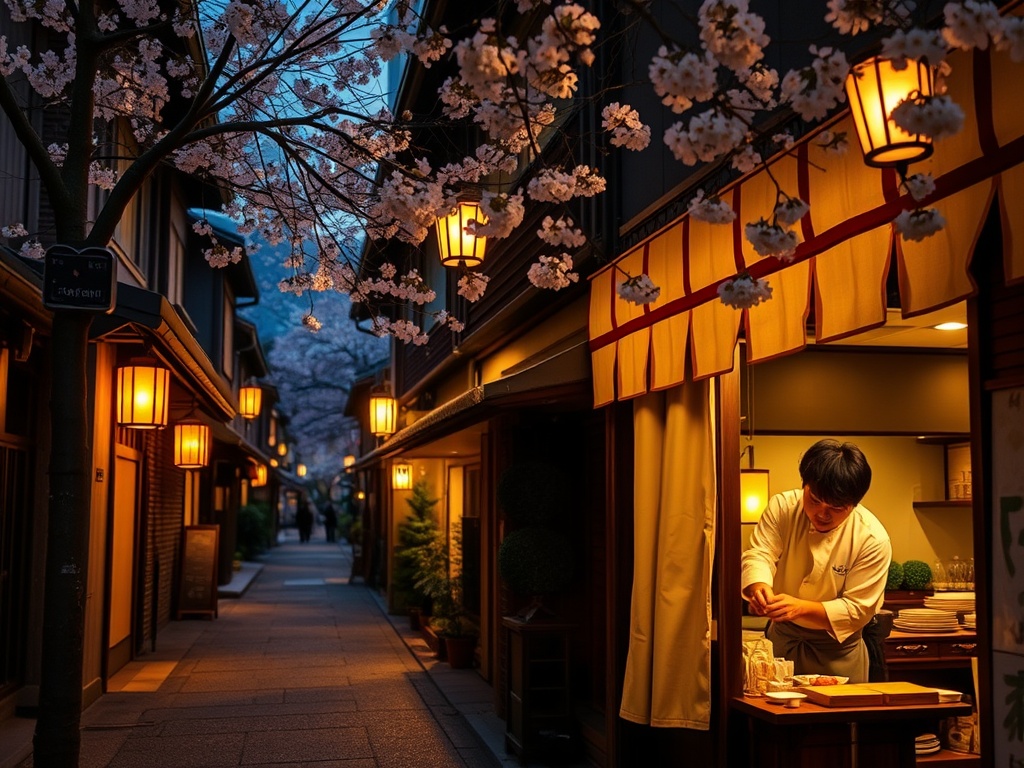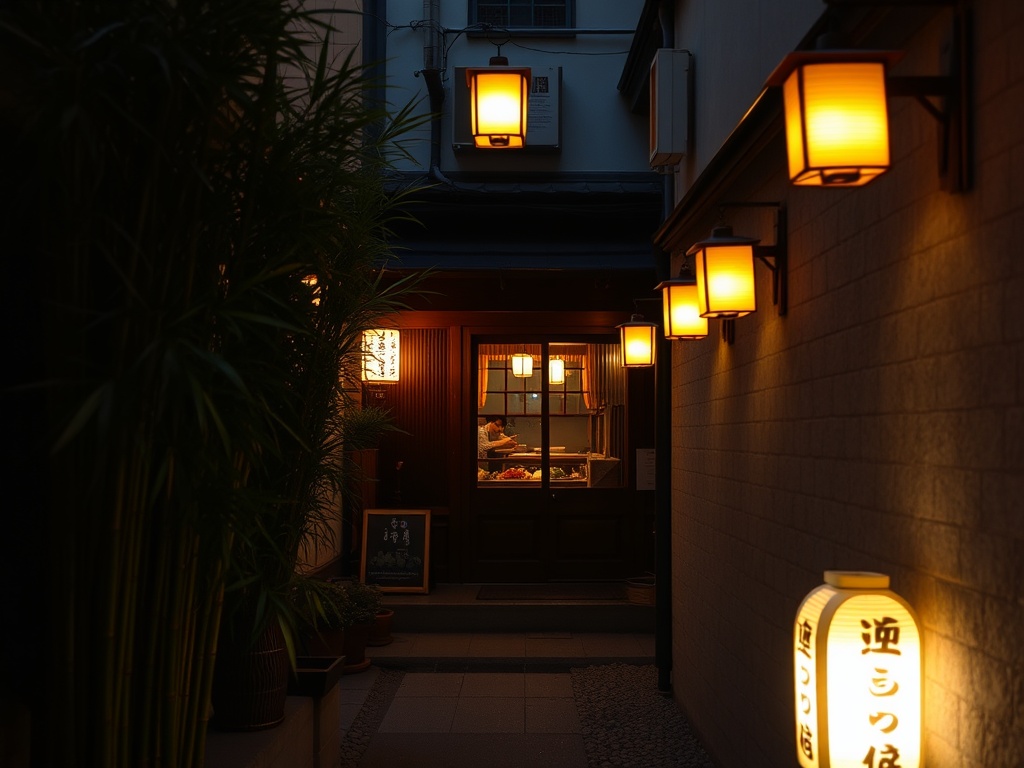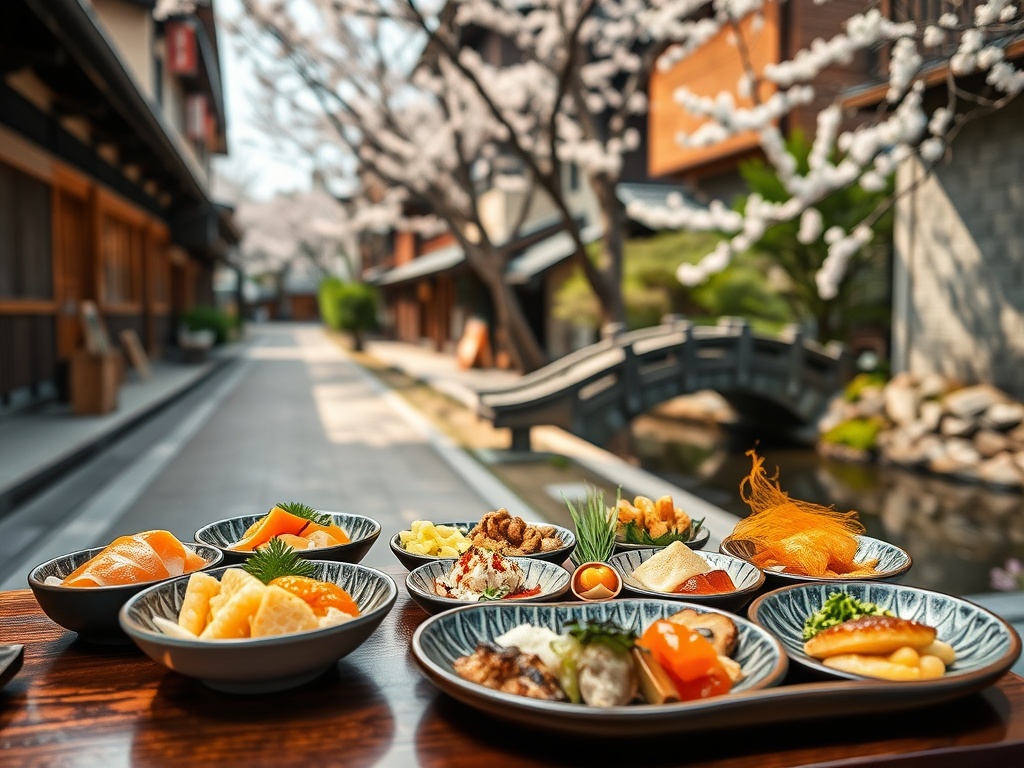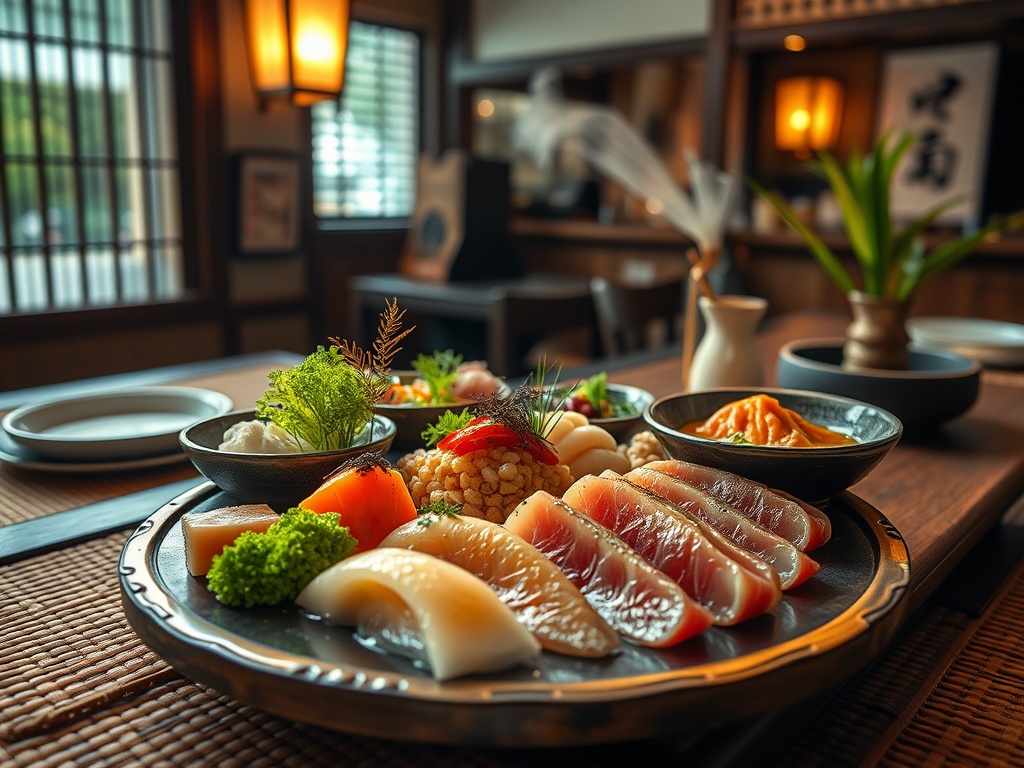Savor the Secrets: Kyoto’s Best Kept Culinary Hideaways
Win a Free Trip to Japan!
Experience cherry blossoms and ancient temples
Embarking on a culinary journey through Kyoto is akin to discovering a secret garden of flavors and traditions. While the city’s famous temples and shrines steal the spotlight, its hidden food gems are the real treasures waiting to be explored. Delight your taste buds with Kyoto’s best-kept culinary secrets that promise not just meals, but unforgettable experiences.
Beyond the bustling markets and popular eateries, Kyoto harbors a myriad of lesser-known spots where gastronomy meets authenticity. These culinary hideaways offer a window into the soul of Kyoto, where every dish tells a story of tradition and innovation. From tucked-away tea houses to family-run izakayas, each location is a chapter in your epicurean adventure.
Ready to venture off the beaten path? Here’s a list of hidden gems that promise to transform your Kyoto trip into a gastronomic adventure:
- Omen Kodai-ji: Experience the art of udon like never before at this quaint noodle house, known for its handmade noodles and serene atmosphere.
- Gion Mametora: Nestled in the historic Gion district, this spot offers a unique take on Kyoto-style kaiseki, artfully prepared with seasonal ingredients.
- Tan Tan: A hidden gem for vegetarian travelers, this cozy café serves delectable plant-based dishes with a Japanese twist.
- Le Petit Mec: Dive into the world of French-inspired pastries with a Japanese flair at this charming bakery, a local secret cherished by pastry lovers.
Each of these locations offers a unique window into Kyoto’s culinary diversity, making them perfect for those looking to savor the city’s true essence.
A Taste of Tradition: Uncovering Kyoto’s Authentic Flavors
In the heart of Kyoto, culinary traditions have been lovingly preserved, offering travelers a rare glimpse into the city’s rich cultural tapestry. Each dish tells a tale, woven with the threads of history and the hands of generations past. As you wander through Kyoto’s winding streets, the aroma of ancient recipes beckons, inviting you to partake in a feast that transcends time. Here, the past and present merge, creating a culinary experience that is both nostalgic and novel.
At the pinnacle of Kyoto’s culinary offerings is kaiseki, an exquisite multi-course dining experience that epitomizes the art of Japanese cuisine. Each course is a delicate balance of taste, texture, and presentation, crafted to highlight the season’s freshest ingredients. Yoshikawa, a secluded establishment known for its tempura kaiseki, offers an intimate setting where diners can savor the harmony of flavors that define this traditional meal.
No visit to Kyoto would be complete without indulging in its array of traditional sweets, or wagashi. These artful confections are not just a treat for the taste buds but are also a feast for the eyes. Nakamura Tokichi, a historic tea house, is renowned for its matcha desserts, offering a serene space to enjoy delicacies like matcha parfaits and yokan. Each sweet creation reflects the beauty of Kyoto’s changing seasons, making them perfect souvenirs of your journey.
- Yudofu: A simple yet refined tofu dish, often served in the peaceful surroundings of a Zen temple.
- Saba Sushi: A mackerel sushi specialty that offers a unique taste of Kyoto’s coastal influences.
- Shojin Ryori: A Buddhist vegetarian cuisine that embodies the principles of balance and harmony.
These culinary experiences offer a gateway into Kyoto’s soul, where tradition and taste unite to create memories that linger long after the meal concludes.
Beyond Sushi: Dive into Kyoto’s Undiscovered Delicacies
When one thinks of Japanese cuisine, sushi often takes center stage. Yet, in the heart of Kyoto, a world of undiscovered delicacies awaits those adventurous enough to look beyond the familiar. While sushi is undoubtedly a staple in Japanese culinary culture, Kyoto offers a treasure trove of flavors that go far beyond the vinegared rice and fish. The city’s secret food scene invites you to delve into its rich gastronomic heritage, where each bite is a revelation and every meal a masterpiece.
Kyoto’s culinary offerings are as diverse as its historical landmarks. This ancient city is a haven for food enthusiasts seeking to explore flavors that are both traditional and innovative. One such delicacy is obanzai, a traditional style of Kyoto home-cooking that emphasizes simplicity and the use of local, seasonal ingredients. Obanzai dishes are often served in small portions, allowing you to savor a variety of flavors in one sitting, each dish telling a story of Kyoto’s cultural and agricultural landscape.
Another hidden gem is yuba, or tofu skin, which is a byproduct of the tofu-making process. This delicate ingredient is cherished for its subtle flavor and silky texture, often served in fine dining establishments or at specialized tofu restaurants. Yuba is a testament to Kyoto’s ability to elevate even the humblest ingredients into culinary art, offering a taste of the city’s commitment to preserving its food traditions while embracing modern influences.
Street food in Kyoto offers a unique twist on familiar snacks, providing an authentic taste of local life. One must-try delicacy is yatsuhashi, a traditional sweet that comes in both baked and unbaked forms. The unbaked version is a soft, chewy confection flavored with cinnamon and filled with sweet red bean paste, while the baked version resembles a crispy cookie. These treats are often sold at street stalls and make for perfect souvenirs.
Another street food delight is takoyaki, bite-sized balls of batter filled with tender pieces of octopus. Although this dish is more commonly associated with Osaka, Kyoto’s take on takoyaki offers a subtle difference in flavor and preparation, making it a must-try for those exploring the city’s culinary streets. These street-side delicacies are not just food but a cultural experience, inviting you to indulge in the vibrant and bustling atmosphere of Kyoto’s outdoor markets.
Tea Time Treasures: Kyoto’s Hidden Teahouse Experiences
Embarking on a journey through Kyoto’s tea culture is akin to stepping back in time, where every sip is steeped in history and tradition. Beyond the well-trodden paths of Kyoto’s famous tea houses lies a realm of hidden teahouses that offer an intimate glimpse into the city’s rich heritage. These secluded spots are the perfect refuge for travelers seeking a peaceful retreat from the bustling city streets, providing a serene setting to enjoy the nuances of traditional Japanese tea ceremonies.
One such hidden gem is Shin-kyotoan, a teahouse nestled in a quaint alleyway, where the art of tea is celebrated in its purest form. Here, guests are invited to partake in a matcha tea ceremony, guided by a skilled tea master who shares stories of the tea’s origins and its cultural significance. The experience is not just about drinking tea; it’s an immersion into a world of tranquility and mindfulness, where each movement and gesture is deliberate and meaningful.
Another must-visit is Chajiya, a lesser-known treasure that offers a contemporary twist on traditional tea experiences. This teahouse blends the old with the new, offering unique tea blends crafted from locally sourced ingredients. The atmosphere is a harmonious fusion of modern design and traditional aesthetics, providing a cozy nook to enjoy creative tea-infused pastries and snacks. Here, the essence of Kyoto’s tea culture is given a new life, making it a perfect spot for those eager to explore the evolution of this ancient practice.
For those seeking something truly off the beaten path, Higashiyama Chaya offers a secluded hideaway where guests can enjoy a private tea session overlooking a tranquil garden. This hidden teahouse is a sanctuary of calm, where the gentle sound of a flowing stream accompanies the delicate aroma of freshly brewed tea. The experience is elevated by the breathtaking view of the garden, a masterpiece of traditional Japanese landscaping that changes with the seasons, offering a unique backdrop for each visit.
These hidden teahouses not only offer a taste of Kyoto’s tea heritage but also provide a deeply personal and immersive experience that transforms a simple tea session into a cherished memory. As you explore these tea time treasures, you’ll discover that Kyoto’s culinary landscape extends far beyond its renowned dishes, offering a rich tapestry of flavors and traditions waiting to be savored.
Street Food Adventures: Explore Kyoto’s Lesser-Known Yatai
Kyoto, a city proud of its culinary heritage, offers more than just traditional restaurants and serene tea houses. For those with a taste for adventure, the city’s lesser-known yatai, or street food stalls, provide a vibrant and flavorful experience that captures the essence of local life. As twilight descends, these hidden stalls come alive, offering a tantalizing array of flavors that showcase Kyoto’s unique take on street food.
While many travelers flock to well-known dining spots, the true heart of Kyoto’s street food scene lies within its bustling night markets. Here, the aroma of sizzling delicacies fills the air, inviting you to explore a world of culinary wonders. From savory snacks to sweet treats, these yatai are a testament to Kyoto’s rich gastronomic diversity and innovation.
- Okonomiyaki: Often referred to as a Japanese savory pancake, Kyoto’s version of okonomiyaki is a must-try, filled with local vegetables and drizzled with tangy sauces.
- Kushiage: These skewered and deep-fried delights come in a variety of options, from vegetables to meats, offering a crispy bite that is as satisfying as it is delicious.
- Imagawayaki: A lesser-known sweet treat, these warm, round pastries are filled with red bean paste or custard, perfect for those with a sweet tooth.
Venturing into Kyoto’s street food scene is not just about the food, but also about embracing the social and cultural ambiance that these yatai encapsulate. Each stall tells a story, from the friendly banter of the vendors to the communal seating arrangements that encourage conversation among strangers. This is where food becomes a bridge, connecting travelers with locals, and creating unforgettable memories.
The charm of Kyoto’s yatai lies in their ability to surprise and delight, offering flavors that are both familiar and exotic. As you wander through the alleys and lanes, each bite is an invitation to discover the soul of Kyoto, hidden in plain sight. It’s a street food adventure that promises to not only satisfy your appetite but also enrich your journey with authentic cultural encounters.
Gastronomic Journeys: Unveil Kyoto’s Artisan Food Craftsmanship
Kyoto, a city renowned for its historical landmarks and serene landscapes, offers a culinary landscape that is equally rich in heritage and innovation. For the discerning traveler, delving into Kyoto’s artisan food craftsmanship is akin to unlocking a treasure chest of flavors, each crafted with precision and care. These hidden culinary ateliers are where tradition meets creativity, offering experiences that transcend the ordinary dining experience and invite you into the heart of Japanese culinary artistry.
Among Kyoto’s gastronomic gems lies its mastery in the art of fermentation, a technique that has been honed over centuries to produce some of Japan’s most cherished flavors. Nishiki Market, often dubbed as ‘Kyoto’s Kitchen’, is a haven for those eager to explore this ancient practice. Here, vendors offer a variety of fermented delicacies, from tangy pickled vegetables known as tsukemono to the umami-rich miso pastes that form the backbone of many traditional dishes. The market itself is a sensory delight, with vibrant colors and enticing aromas that beckon travelers to taste and learn. Engaging with local artisans at these stalls provides a deep dive into the cultural significance and meticulous process behind fermentation, offering a taste of Kyoto’s culinary soul.
In Kyoto, the pursuit of perfection is not limited to its architecture or gardens but extends deeply into its culinary arts. Take a culinary journey to one of the city’s lesser-known tofu workshops, where the simplicity of soybeans is transformed into delicate tofu creations. These workshops are not just places of production but are cultural institutions where the philosophy of humility and respect for ingredients is taught alongside practical skills. Visitors are often invited to participate in the process, experiencing firsthand the care and precision that goes into each block of tofu. This immersive experience highlights the importance of craftsmanship in Kyoto’s food scene, where every dish is a testament to the city’s dedication to quality and tradition.
Kyoto’s artisan food craftsmanship is more than just a culinary exploration; it is a journey into the heart of Japanese culture, where each bite is a narrative of history, dedication, and artistry. As you uncover these hidden gems, you’ll find that Kyoto’s food artisans are not just creators, but storytellers, sharing the essence of Japan through their culinary masterpieces.
Sweet Surprises: Indulge in Kyoto’s Hidden Dessert Havens
While Kyoto is renowned for its traditional flavors and culinary artistry, the city’s hidden dessert havens offer an unexpected journey into the world of sweets that will delight even the most discerning palates. Tucked away in narrow alleys and historic districts, these dessert spots capture the essence of Kyoto’s rich cultural tapestry, where each confection is a work of art and a burst of flavor.
Discover the delicate beauty of Kyoto’s lesser-known wagashi shops, where traditional Japanese sweets are crafted with meticulous attention to detail. Each piece is a celebration of seasonal ingredients and artistic expression, making for an indulgent experience that is both visually stunning and delicious.
One such destination is Toraya, a historic confectioner known for its exquisite wagashi that embody the elegance of Kyoto’s seasons. Their yokan, a sweet bean jelly, showcases the harmonious blend of texture and flavor, creating a taste sensation that lingers long after the last bite.
In Kyoto, the art of dessert-making extends beyond the traditional, embracing innovative flavors that surprise and delight. At Kyoto Saryo, the fusion of Japanese and Western dessert techniques results in unique creations that are a testament to the city’s culinary evolution. Their signature matcha tiramisu is a must-try, offering a rich, creamy experience infused with the distinctive taste of high-quality green tea.
For a whimsical twist, head to Sweets of Kyoto, where the playful presentation of desserts like mochi ice cream and green tea parfaits provide a delightful treat for the senses. These innovative sweet spots not only satisfy your taste buds but also offer a fresh perspective on Kyoto’s vibrant dessert scene.
- Shimizu Teahouse: Enjoy their famous matcha shaved ice, a refreshing dessert perfect for warmer days.
- Shinise: Known for their delicate nama-yatsuhashi, a soft confection infused with cinnamon and filled with sweet bean paste.
- Kyo Hayashiya: A dessert haven offering an array of matcha-infused sweets, from parfaits to cakes.
These hidden dessert havens are not just places to satisfy a sweet craving; they are gateways to exploring Kyoto’s innovative spirit and culinary heritage. Each sweet surprise invites you to savor a piece of Kyoto’s soul, ensuring your journey is as sweet as it is memorable.
Culinary Time Travel: Dining in Kyoto’s Historic Eateries
Embarking on a culinary journey through Kyoto is akin to stepping into a time machine that whisks you away to eras long past. This ancient city, with its labyrinth of cobblestone streets and wooden teahouses, offers a dining experience that is both a tribute to tradition and a portal to the past. Here, every bite is imbued with the essence of centuries-old recipes, offering food and history enthusiasts an unforgettable taste of Japan’s rich cultural heritage.
In Kyoto, dining is not merely about savoring flavors; it’s about experiencing a story that has been told through generations. Historic eateries, often nestled in quaint alleys or overlooking serene gardens, serve dishes that are as much about preservation as they are about taste. At Kyo-ryori Kaji, a revered establishment dating back to the Edo period, diners are treated to a kaiseki meal that celebrates seasonal ingredients with meticulous artistry. Each course is a step back in time, where the culinary art of Kyoto is presented in its most authentic form.
Another must-visit is the legendary Honke Owariya, a soba noodle shop that has been delighting patrons since 1465. Stepping inside, you’ll find yourself immersed in a setting that exudes history, from the rustic wooden interiors to the subtle aroma of freshly prepared buckwheat noodles. Dining here is a ritual, where the simplicity of soba is elevated to an art form, a testament to the enduring legacy of Kyoto’s culinary mastery.
Kyoto’s historic eateries are more than just dining venues; they are guardians of culinary traditions that have been passed down through the ages. These establishments often adhere to age-old cooking methods, ensuring that each dish is a faithful representation of its historical roots. At Hyotei, a teahouse and restaurant with over 400 years of history, the emphasis is on the delicate balance of flavors and the aesthetic presentation of food. The tranquil surroundings and the precision of each dish make dining here a journey of mindfulness and appreciation.
For those seeking to delve deeper into Kyoto’s gastronomic past, a visit to Okariba offers a unique experience. Known for its wild game dishes, this rustic spot combines ancient recipes with the bold flavors of Kyoto’s mountainous regions. Here, the past comes alive on your plate, offering a taste of the city’s untamed culinary spirit.
These historic eateries are not just places to eat but are experiences that transport you through time, offering a glimpse into the culinary soul of Kyoto. They are a reminder that in this city, food is not just a necessity but a cherished tradition that continues to thrive, captivating travelers from around the world.



